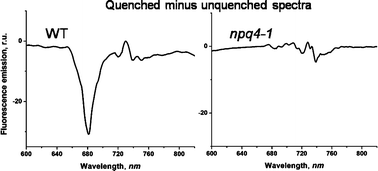PsbS-specific zeaxanthin-independent changes in fluorescence emission spectrum as a signature of energy-dependent non-photochemical quenching in higher plants†
Abstract
The PsbS

* Corresponding authors
a
Department of Molecular Biology, Pusan National University, Busan, Korea
E-mail:
chlee@pusan.ac.kr
Fax: +82 51 513 9258
Tel: +82 51 510 2280
b
Institute of Botany, Azerbaijan National Academy of Sciences, Patamdar Shosse 40, Baku, Azerbaijan
E-mail:
iszulfugarov@pusan.ac.kr
Fax: +994 12 4955045
Tel: +994 12 4955045
c Department of Plant Bioscience, Pusan National University, Miryang, Korea
The PsbS

 Please wait while we load your content...
Something went wrong. Try again?
Please wait while we load your content...
Something went wrong. Try again?
I. S. Zulfugarov, A. Tovuu, B. Dogsom, C. Y. Lee and C. Lee, Photochem. Photobiol. Sci., 2010, 9, 697 DOI: 10.1039/B9PP00132H
To request permission to reproduce material from this article, please go to the Copyright Clearance Center request page.
If you are an author contributing to an RSC publication, you do not need to request permission provided correct acknowledgement is given.
If you are the author of this article, you do not need to request permission to reproduce figures and diagrams provided correct acknowledgement is given. If you want to reproduce the whole article in a third-party publication (excluding your thesis/dissertation for which permission is not required) please go to the Copyright Clearance Center request page.
Read more about how to correctly acknowledge RSC content.
 Fetching data from CrossRef.
Fetching data from CrossRef.
This may take some time to load.
Loading related content
